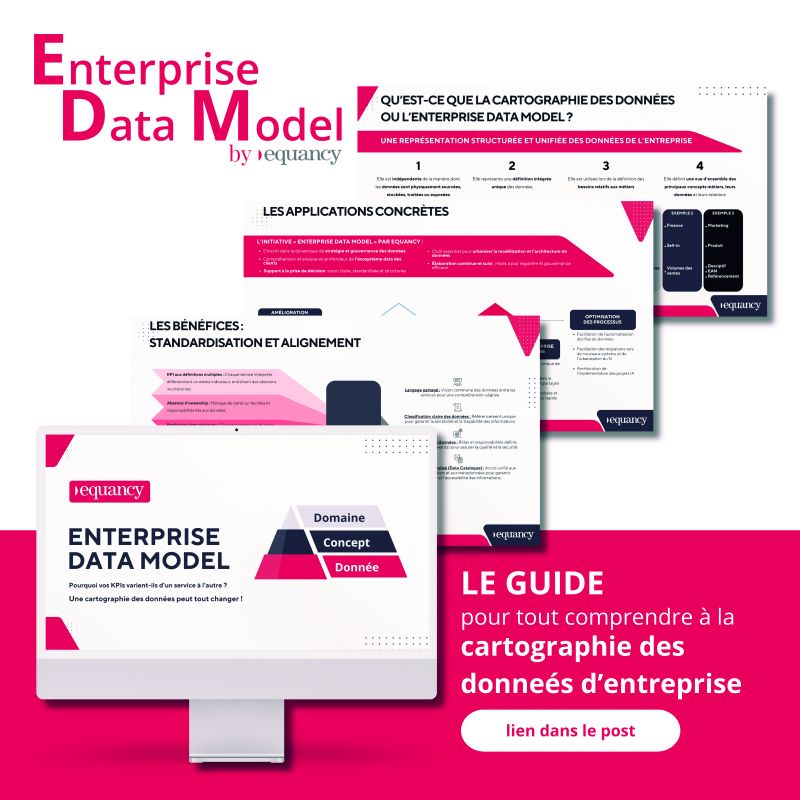Smart Business Intelligence - How to accelerate at each level of maturity?
HUB Institute: What is the state of the art in BI according to Equancy ?
Thomas Potus : At Equancy, we distinguish 3 main levels of maturity within companies:
- The first concerns all the players who have already taken the step towards new, more modern, user-friendly and agile BI tools; these players are still very rare because the current needs are numerous and evolving very quickly, and the change in technology has a heavy impact on the IT side but also in terms of change management for the users of these solutions.
- The second level of maturity represents the majority of companies: these players are in the process of making this transition, and have often started to work with certain departments, particularly digital and marketing, which are very demanding and are often poorly served by traditional BI.
- Finally, the third level of maturity includes all the players who have not yet taken the step towards this new transition.
HUB Institute: What is motivating companies to change their BI mindset ?
Thomas Potus : this transformation is primarily driven by 3 major trends.
- The first is the arrival of new cloud solutions (Qliksense, PowerBI Tableau Software) that are highly interactive and offer a new user experience compared to the traditional BI players.
- The second is the increasing presence of data lakes in companies' digital ecosystems. The latter will play a facilitating role, and will make it easier to centralise and communicate data within the company.
- The third is the need to acquire more and more flexibility and agility in reporting. With digital technology, and especially with the complicated economic situation linked to COVID, everything has to move faster. We can no longer afford to wait for our figures, we can no longer follow the traditional BI cycle with long development times.
HUB Institute: What challenges do companies face in order to equip themselves with more intelligent and efficient BI tools ?
Didier Richaudeau: The first challenge is the choice of tool. And often the issue is not so much choosing a new tool as killing all the other BI tools in the company. If you really want to transform the whole company, you have to choose a single tool, and therefore sacrifice all the others.
The second issue is again to discard one tool: Excel. This is a complex task which implies demonstrating the value of these new tools compared to Excel. You have to train people and show them that, although it will be a bit complicated at the start because it is a new tool, they will save a lot of time in the end.
The third issue is governance, with two important aspects:
- Data: it is necessary to understand what data is being manipulated, and clear definitions must be established. It is often the role of the business to define the right way to calculate a metric. It must then be disseminated within the company.
- Quality: if the quality is not there, it will kill the added value, perceived and real, of these BI applications. Everyone is concerned by data quality: it is a day-to-day issue that requires governance and processes to be put in place to monitor and maintain quality over time.
HUB Institute: What are the steps involved in transforming BI into Smart BI?
-
Corporate BI: the aim is to provide centralized reporting, drafted by the IT teams and governed by these same teams, in order to guarantee the key figures of a company. You don't play with a company's key indicators and you don't change their definitions according to your expectations.
- BI self-service: just like corporate BI, based on standardised data visualisation applications, this involves providing a first level of flexibility. This will allow the user to customize the analyses, modify certain axes, and enrich the model with his own metrics and definitions. At Equancy, we are betting that tomorrow the majority of businesses will be covered by this operating mode.
- Open BI: for the most mature professions, it is essential to be able to explore and analyze their data sets themselves. We are thinking in particular of management control, CRM or digital professions which generally have in-house data analysts who will need to build their own data-visualization application.
"To believe in a one-size-fits-all BI would be to underestimate the complexity of needs within a society."
- Thomas Potus, Senior BI & Dataviz Consultant -
HUB Institute: What are the next BI challenges to address ?
Didier Richaudeau: Let's assume that you have access to the data, with a user-friendly tool. So you have the basis of your BI application and the numbers are available to you.
- The first challenge is to find a way to automatically analyse all these numbers, in order to identify the important ones. Making BI intelligent means having automated processes that are capable of both spotting the figures that change the trend, but also automatically identifying the dimensions, metrics, KPIs that explain this trend evolution, so that you no longer have to look at and analyse all the dimensions manually.
- The second challenge, in my opinion, is to stop looking at the rear-view mirror. Historically, a BI system only analyses the figures from the past. However, for a company, it is necessary to anticipate the future! It is therefore necessary to integrate forecasts into the BI, in order to be able not only to certify that the situation to date is correct, but also to project the trends into the future in order to predict whether or not the annual objective will be achieved, for example.
- Finally, the "ultimate stage", and there is still a lot to be done on this subject, is to make BI tools, decision support tools, on which it is possible to simulate scenarios: if I invest more in this type of channel, if I push this type of promotion, how will this impact my future sales? To do this, the machine learning and data science part must be integrated into the BI. Only a few players are already at this advanced stage of using data and BI, and very often only in certain departments of the company.
Watch the full interview on our YouTube channel :
Didier Richaudeau
Data associate




